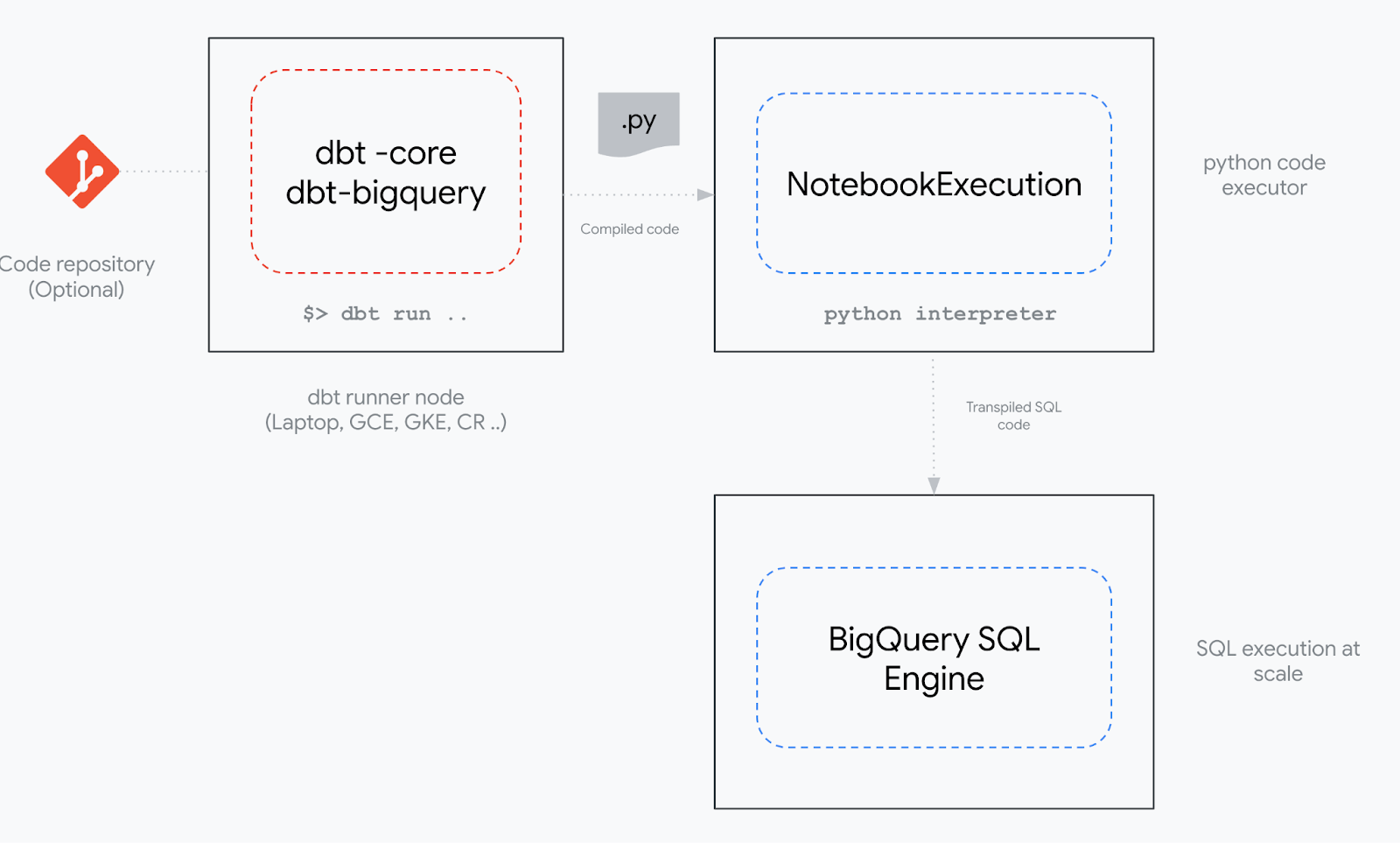Using BigQuery DataFrames with dbt Python models
Introduction
In this guide, you'll learn how to set up dbt so you can use it with BigQuery DataFrames (BigFrames):
- Build scalable data transformation pipelines using dbt and Google Cloud, with SQL and Python.
- Leverage BigFrames from dbt for scalable BigQuery SQL.
In addition to the existing dataproc/pyspark based submission methods for executing python models, you can now use the BigFrames submission method to execute Python models with pandas-like and scikit-like APIs, without the need of any Spark setup or knowledge.
BigQuery DataFrames is an open source Python package that transpiles pandas and scikit-learn code to scalable BigQuery SQL. The dbt-bigquery adapter relies on the BigQuery Studio Notebook Executor Service to run the Python client side code.
Prerequisites
- A Google Cloud account
- A dbt account
- Basic to intermediate SQL and python.
- Basic understanding of dbt fundamentals. We recommend the dbt Fundamentals course.
What you'll build
Here's what you'll build in two parts:
- Google Cloud project setup
- A one-time setup to configure the Google Cloud project you’ll be working with.
- Build and Run the Python Model
- Create, configure, and execute a Python model using BigQuery DataFrames and dbt.
You will set up the environments, build scalable pipelines in dbt, and execute a python model.
Figure 1 - Implementation of the BigFrames submission method for dbt python models
Configure Google Cloud
The dbt BigFrames submission method supports both service account and OAuth credentials. You will use the service account in the following steps.
-
Create a new Google Cloud Project
a. Your new project will have the following list of APIs already enabled, including BigQuery, which is required.
b. Enable the BigQuery API which also enables the following additional APIs automatically
-
Create a service account and grant IAM permissions
This service account will be used by dbt to read and write data on BigQuery and use BigQuery Studio Notebooks.
Create the service account with IAM permissions:
#Create Service Account
gcloud iam service-accounts create dbt-bigframes-sa
#Grant BigQuery User Role
gcloud projects add-iam-policy-binding ${GOOGLE_CLOUD_PROJECT} --member=serviceAccount:dbt-bigframes-sa@${GOOGLE_CLOUD_PROJECT}.iam.gserviceaccount.com --role=roles/bigquery.user
#Grant BigQuery Data Editor role. This can be restricted at dataset level
gcloud projects add-iam-policy-binding ${GOOGLE_CLOUD_PROJECT} --member=serviceAccount:dbt-bigframes-sa@${GOOGLE_CLOUD_PROJECT}.iam.gserviceaccount.com --role=roles/bigquery.dataEditor
#Grant Service Account user
gcloud projects add-iam-policy-binding ${GOOGLE_CLOUD_PROJECT} --member=serviceAccount:dbt-bigframes-sa@${GOOGLE_CLOUD_PROJECT}.iam.gserviceaccount.com --role=roles/iam.serviceAccountUser
#Grant Colab Entperprise User
gcloud projects add-iam-policy-binding ${GOOGLE_CLOUD_PROJECT} --member=serviceAccount:dbt-bigframes-sa@${GOOGLE_CLOUD_PROJECT}.iam.gserviceaccount.com --role=roles/aiplatform.colabEnterpriseUser -
(Optional) Create a test BigQuery Dataset
Create a new BigQuery Dataset if you don't already have one:
#Create BQ dataset
bq mk --location=${REGION} echo "${GOOGLE_CLOUD_PROJECT}" | tr '-' '_'_dataset -
Create a GCS bucket to stage the python code, and store logs
For temporary log and code storage, please create a GCS bucket and assign the required permissions:
#Create GCS bucket
gcloud storage buckets create gs://${GOOGLE_CLOUD_PROJECT}-bucket --location=${REGION}
#Grant Storage Admin over the bucket to your SA
gcloud storage buckets add-iam-policy-binding gs://${GOOGLE_CLOUD_PROJECT}-bucket --member=serviceAccount:dbt-bigframes-sa@${GOOGLE_CLOUD_PROJECT}.iam.gserviceaccount.com --role=roles/storage.admin
Create, configure, and execute your Python models
-
In your dbt project, create a SQL model in your models directory, ending in the
.sqlfile extension. Name itmy_sql_model.sql. -
In the file, copy this SQL into it.
select
1 as foo,
2 as bar -
Now create a new model file in the models directory, named
my_first_python_model.py. -
In the
my_first_python_model.pyfile, add this code:def model(dbt, session):
dbt.config(submission_method="bigframes")
bdf = dbt.ref("my_sql_model") #loading from prev step
return bdf -
Configure the BigFrames submission method by using either:
a. Project level configuration via dbt_project.yml
models:
my_dbt_project:
submission_method: bigframes
python_models:
+materialized: viewor
b. The Python code via dbt.config in the my_first_python_model.py file
def model(dbt, session):
dbt.config(submission_method="bigframes")
# rest of the python code... -
Run
dbt run -
You can view the logs in dbt logs. You can optionally view the codes and logs (including previous executions) from the Colab Enterprise Executions tab and GCS bucket from the GCP console.
-
Congrats! You just created your first two python models to run on BigFrames!
Was this page helpful?
This site is protected by reCAPTCHA and the Google Privacy Policy and Terms of Service apply.
